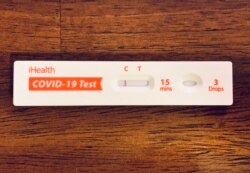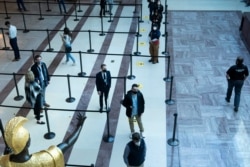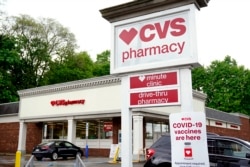Across the country, Americans are finding it hard to get tested for the coronavirus as the omicron variant sparks record numbers of infections after a holiday period that saw tens of millions travel to spend time with loved ones.
The Biden administration will soon require health care insurers to cover the costs of up to eight home test kits per person per month. There’s just one problem: for many people, finding even one home test is nearly impossible.
“I had planned a trip to France long before omicron began,” said Katelyn Umholtz, a New Orleans-based journalist. “And we were careful while traveling. But when I got home I had a sore throat, so I tested myself with a kit I had purchased back when they were available.”
Umholtz tested negative for coronavirus, but a few days later her symptoms worsened. She tested herself again, using the last test kit she had, and this time it indicated she was infected. That was more than a week ago. Her symptoms have subsided, but Umholtz told VOA that finding a test to see if she’s now negative for the coronavirus hasn’t been easy.
“I need to see if it’s safe for me to go back to work,” she said, “but the next available appointment for a test isn’t for another week. And most stores are totally sold out of home tests, so the only option is to keep looking, or to go to a public testing station run by the city, where you might wait in line for hours. I was too sick to do that last week, and this week I’m working from home so I can’t spare the time.”
New Orleans Health Department Director Jennifer Avegno said there is little local governments can do to improve the situation until the supply of home tests is replenished.
“We placed an order for tens of thousands of tests almost a month ago, but have yet to receive it,” Avegno explained. “Our PCR test sites are open, but they’re very busy, and that’s made the turnaround time for even those test results significantly longer.”
Value of testing
“It’s been clear for some time that a single mitigation strategy, such as focusing solely on vaccinations, is insufficient to prevent widespread transmission, disease, and morbidity,” Avegno explained. “To be most effective, communities need to have layered mitigation measures —vaccinations, masks, and testing — working together.”
Avegno added that even though omicron generally results in milder illness than previous variants, the lightning speed at which the virus spreads through a community can cause significant disruptions in the workforce, impacting a broad range of vital services and businesses.
“Especially because tests are such a strong part of the new isolation and quarantine guidance being recommended, having rapid tests widely available would play a large part in preserving business function, decreasing spread, and keeping schools open.”
Marilia Rodrigues said she knows firsthand the importance of access to testing.
She lives in Philadelphia with her husband and two young children. After driving home from Florida where they were visiting family for the holidays, Rodrigues’ husband and 4-year-old son tested positive.
“My daughter and I just had a light cough — the kind you get in the winter when the heat in your house is dry,” Rodrigues told VOA. “So if my husband and son weren’t already sick with COVID, I wouldn’t have thought I had it, or to test.”
She managed to find tests for herself and her daughter. Both came back positive.
“I would have gone to work and my daughter would have gone to school. Who knows how many people we could have gotten sick without even knowing it?”
Complicated situations
“The situation for each individual family is just so complex,” Rodrigues continued. “Among my daughter, my son, and I — to go back to work or school, we’re all required to show proof of different tests, and we all have different amounts of time we have to quarantine before we’re allowed to return.”
Rodrigues said the family has spent countless hours searching for tests and appointments online, and has spent hundreds of dollars to purchase the appropriate home tests.
“Trust me, we understand how lucky we are in all of this,” she said. “For a family who doesn’t have the time or money to seek out tests like we did, or who don’t have flexibility that my husband and I do with work, I’m sure it’s much, much worse.”
For many people, a negative coronavirus test is the final hurdle to clear before exiting quarantine and resuming normal activities.
Victoria Truscello Haynes from Newark, Delaware, said a member of her family of five recently received a positive antigen test. Their doctor said they should all assume they are infected unless tests prove otherwise. Haynes has been trying in vain for more than a week to get her family tested.
“I need to get them all tested before they can go back to school, but it’s been impossible,” she said. “I can bring them to an urgent care [center], but you have to pay and it will be a three- or four-day wait before you can get an appointment. I could stand in line at a public facility, but that’s hours in freezing weather with my children aged 18 months to 9 years old. So instead, I’ve just spent the week shuttling my family — including some who are still sick — around trying to find tests. And we still can’t find them. So when can I get my kids back into school?”
Placing blame
As frustrations mount, many wonder who is to blame for a nationwide shortage of home test kits as well as the inability of many testing sites to handle the sudden surge in demand.
“I know it must be a very complicated situation with supply chain challenges and so many people getting sick that it’s affecting even having enough medical personnel to test and treat people,” Rodrigues said, “but certainly you’d hope we’d be better prepared with tests nearly two years into the pandemic.”
Much of the frustration many Americans are feeling has been directed at the Biden administration. Polls aggregated by the website FiveThirtyEight.com show only 46.6% of Americans approve of how President Biden has responded to the coronavirus crisis. The percentage is a record low for the president.
“Those of us who experienced the devastating summer delta variant surge spoke out [about] the need to continue high levels of test availability,” said Dr. Avegno. “Unfortunately, I don’t think that was heeded.”
Avegno acknowledged that few predicted the country would face two highly infectious variants back-to-back. Even so, Biden acknowledged in a recent virtual call with U.S. state governors that his efforts regarding testing availability have fallen short and must improve.
Some of those improvements appear to be on the way. In addition to requiring private health insurers to cover the costs of home test kits beginning January 15, the federal government plans to launch a website later this month that will make 500 million at-home tests available to be mailed to people.
For Mark Hébert of New Orleans, the tests can’t arrive soon enough. He said he’s been searching for weeks with no luck.
“It would have been nice to go home for the holidays with peace of mind,” Hébert said, “knowing I wasn’t bringing a virus with me.”
Still, he is trying to accentuate the positive amid the testing shortage.
“I think it’s a sign of the public’s increasing sense of responsibility in ending this pandemic. You can see people are trying to do the right thing. That’s why they’re testing.”











